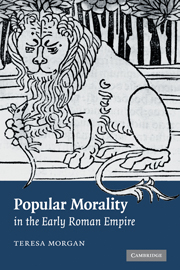Book contents
- Frontmatter
- Contents
- Preface
- List of illustrations
- List of tables
- List of abbreviations
- 1 Introduction
- PART ONE
- PART TWO
- PART THREE
- Conclusion
- Appendix 1 The political and literary connections of Babrius
- Appendix 2 The definition of a miscellany
- Appendix 3 Popular morality and philosophical doctrine
- List of papyri
- Bibliography
- Index
Appendix 1 - The political and literary connections of Babrius
Published online by Cambridge University Press: 27 October 2009
- Frontmatter
- Contents
- Preface
- List of illustrations
- List of tables
- List of abbreviations
- 1 Introduction
- PART ONE
- PART TWO
- PART THREE
- Conclusion
- Appendix 1 The political and literary connections of Babrius
- Appendix 2 The definition of a miscellany
- Appendix 3 Popular morality and philosophical doctrine
- List of papyri
- Bibliography
- Index
Summary
Our dating of Babrius depends on P. Oxy. 1249, a papyrus fragment containing Fables 18, 110, 118 and 25, which Grenfell and Hunt dated to ‘hardly … later than the end of the second century, and [it] may easily go back to the first’. Babrius' fables are addressed to a ‘son of King Alexander’ (pr. 2.1–2). The only King Alexander we know of in the first or second century ce, is a man who was established on the throne of Rough Cilicia (or part of it) by Vespasian, probably in 72. Babrius could have been teacher to the son, who may or may not be the Branchus who is addressed in the prologue to the first book (l.2).
Of Alexander, we know only the name and two data about his career. He was, however, a small fish in a large pond, in which there were few other fish to whom he was not related by blood, marriage or patronage. He was the son of Tigranes V, whom Nero established as client king of Armenia and against whom Corbulo campaigns in Tacitus' Annals 14–15. His great-uncle, Tigranes IV, had also been king of Armenia, until he was prosecuted and executed at Rome in 36 (Ann. 6.40). Tigranes IV was a grandson of Herod the Great, and so part of a sprawling, interconnected, feuding group of families who between them controlled most of the client kingdoms of the Near East for more than two centuries.
- Type
- Chapter
- Information
- Popular Morality in the Early Roman Empire , pp. 326 - 330Publisher: Cambridge University PressPrint publication year: 2007



